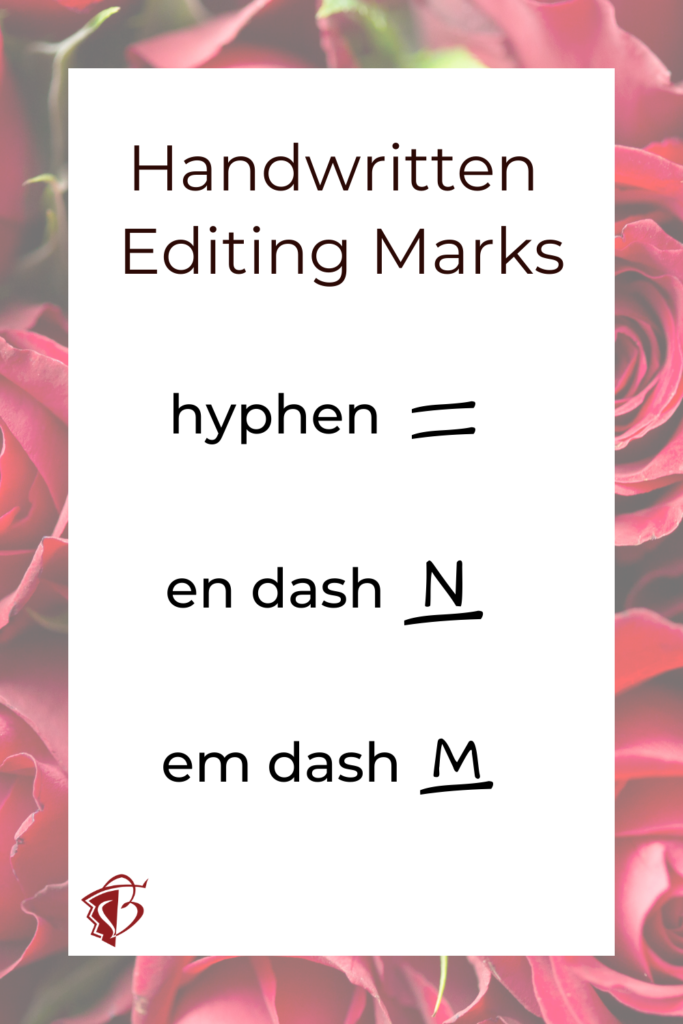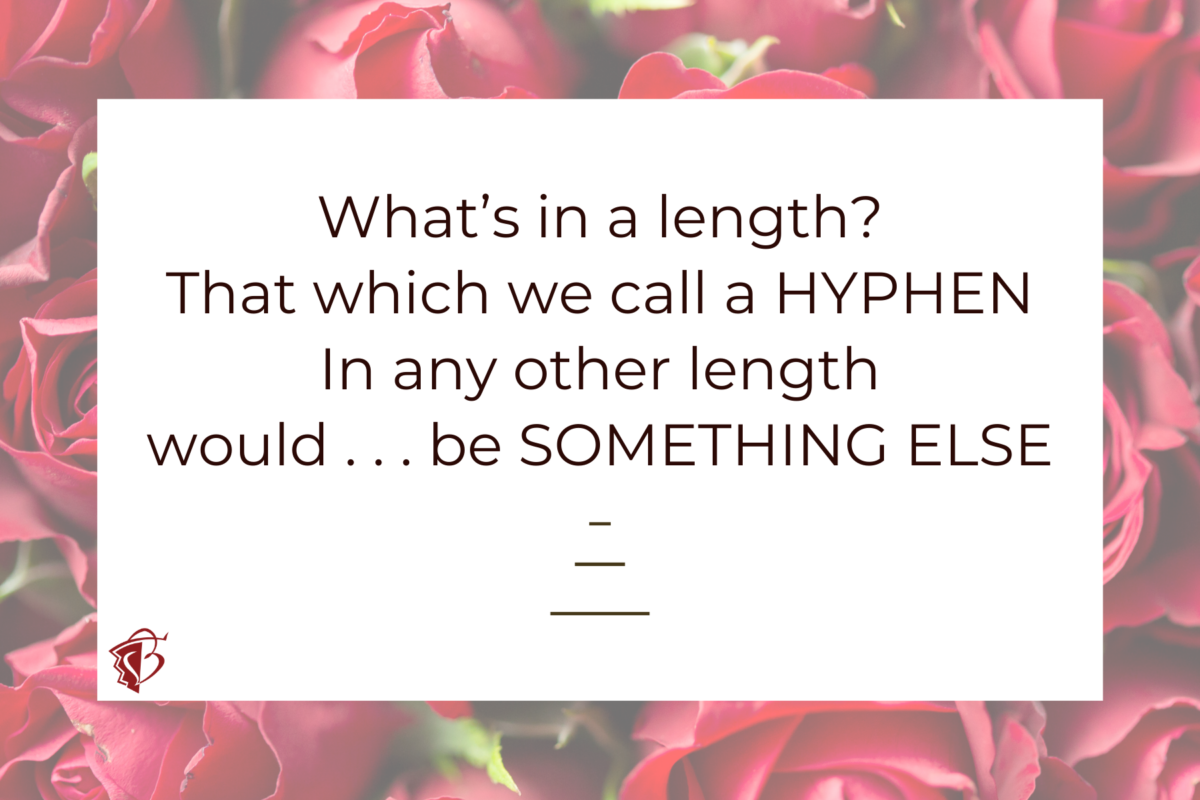The which
The first task in regard to em dashes, en dashes, and hyphens is to learn the physical distinctions between these horizontal marks. In traditionally designed typefaces, the em dash is the longest of the three and is the width of the capital letter M. The en dash is one-half the length of the em dash and is the width of the capital letter N. The hyphen is one-half the length of the en dash.

The how
When editing or proofreading with pencil and paper, the traditional method of marking em dashes is an M with a line under it, en dashes is an N with a line under it, and hyphens is two lines or a long equal sign (see image). These and other proofreading marks are shown in figure 2.6 of the 17th edition of The Chicago Manual of Style (CMOS).
For editing on a PC in Microsoft Word, you have at least two possible methods available to insert these characters. To use the software to insert an em dash or an en dash, click INSERT, and then SYMBOL, and then MORE SYMBOLS, and then SPECIAL CHARACTERS. The em dash is the first on the list and the en dash is just below it. At this point, you have two options. You can either use the key combination given for the dash you need or you can place your cursor at the desired point of insertion and press INSERT. The hyphen is found on the top row of letters on your keyboard, just above and to the right of the letter P.
Another method is to use Alt codes to insert special characters. Simply press and hold down the Alt key on a PC while typing the character code on the numeric keypad. For example, Alt+0150 inserts an en dash, and Alt+0151 inserts an em dash. A recent PC World article provides more information on Alt codes. Lifewire.com published a helpful article about using Alt codes (or the Option key) on a Mac.
The why
The third task for authors and editors is to learn the uses of these three horizontal marks.
The em dash
The em dash is the easiest of the three marks to learn how to use. Long-established style guide Words into Type by Marjorie E. Skillin notes that the most common uses of the em dash are “to mark a suspension of the sense, a faltering in speech, a sudden change in construction, or an unexpected turn of thought.” CMOS tells us that the em dash can be used as an alternative to parentheses or in conjunction with a series of items separated by commas.
EXAMPLE: Three officers—the president, the manager, and the foreman—attended the meeting.
In general, editors should exercise caution in inserting em dashes if the author has not used any. Many older or more conservative authors frown upon the use of em dashes.
The en dash
The principal use of the en dash is to connect continuing or inclusive numbers. Basically, it represents the word “to” between figures or words.
EXAMPLE: They closely studied pages 15–18 of the 1978–1983 report.
An en dash should not be used, however, if part of the range is expressed with a word.
EXAMPLE: They closely studied the pages from 15 to 18. (It would be incorrect to write “They closely studied the pages from 15–18.”)
The hyphen
“If you take hyphens seriously, you will surely go mad.” So said John Benbow as long ago as 1937. (Benbow was the author of Manuscript and Proof, which described the preparation of a manuscript for the Oxford University Press at the time.) To avoid going mad, remember that we hyphenate words to facilitate reading and to prevent ambiguity.
Hyphens are used to connect two elements to function as one unit.
EXAMPLES: twenty-five, cross-reference, self-conscious, one-half
Hyphens also are used to connect two elements for a specific purpose and to avoid misreading.
EXAMPLE: six-hundred-pound bears (meaning several bears that weigh six hundred pounds each) as opposed to six hundred-pound bears (meaning six bears that weigh one hundred pounds each)
Hyphens are used to combine two or more words to modify a noun when the words act as an adjective and are used before the noun.
EXAMPLES: multiple-use trails, site-specific plans, on-leash regulations
Hyphens usually are not used when the adjectives appear after the noun.
EXAMPLES: The area has multiple uses. The management plans are site specific.
Hyphens are used to create compound adjectives that consist of a number and a unit of measurement used before the noun.
EXAMPLES: 100-year flood, a 13-mile-long path, 80-acre property
Hyphens usually are not used when the adjectives appear after the noun.
EXAMPLES: The path is three miles long. The ditch easement is 50 feet.
CMOS contains a multipage guide for compounds and words formed with prefixes. It would take several blogs to summarize this extensive section; therefore I offer only one example.
Hyphenate a compound that occurs before a noun.
EXAMPLE: He wore an emerald-green tie.
Do not hyphenate a compound that comes after the noun.
EXAMPLE: His tie is emerald green.
As you can see, it is possible to “go mad” when deciding about how and where to use hyphens, but with guidelines from CMOS and other style manuals, editors and authors can make it through this seemingly dense thicket and remain sane.
In sum, em dashes, en dashes, and hyphens are physically distinct and have very different uses. This brief article provides only a glimpse into the numerous much more in-depth discussions that exist. Entire chapters delve into the complexities of dashes and hyphens. If you want to dive in, the titles provided below are a great place to begin.
- The Chicago Manual of Style, 17th edition. University of Chicago Press, 2017.
- Sabin, William A. Gregg Reference Manual, 10th edition. McGraw-Hill/Irwin, 2005.
- Crews, Frederick. The Random House Handbook, 6th edition. McGraw-Hill, 1991.

Thank you, Alice. These three marks convey a lot of meaning when used correctly. Your post is really helpful, and I love the examples.
Thanks, Alice. As a lover of em dashes—who can resist them?—I loved your post!
This is a wonderful summary of all the dashes, Alice. So useful. And funny too. John Benbow has said it all. You will surely go mad taking hyphens too seriously!
Referring my writing clients to this excellent overview. Nicely summarized, Alice!
Excellent explanations, Alice. On a Mac, the hyphen is one click on the hyphen key; an en dash is hold down the option key while clicking the hyphen key; and an em dash is hold down the option and shift keys while clicking the hyphen key. Bingo!
You beat me to it, John! I work on a Mac too, so I use Shift + Option + the hyphen key for an m-dash and Option + the hyphen key for an n-dash.
I love em dashes, but they can be overused. So, as a rule, I urge people not to have more than one sentence with em dash/dashes in it. Too many of them close together can be distracting to the eye, and their use is meant to simplify complex sentences.
Great job on this post, Alice! I love how you’ve broken up this information in a way that is easy to read and clearly organized. Thanks!
Alice, thank you for adding this important information to the BE blog. And yes, John and Laurel—I’m with you!